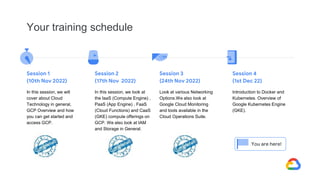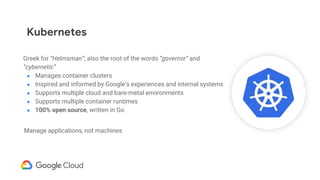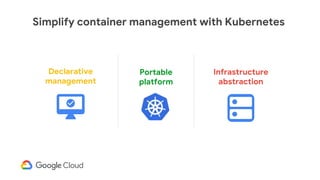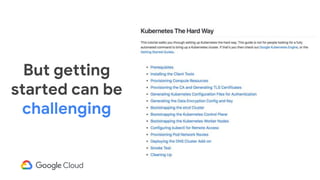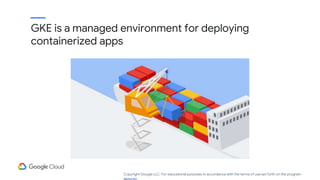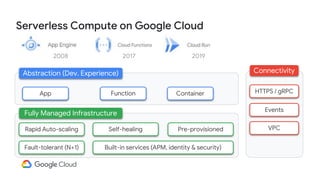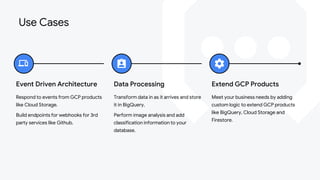Session 4 GCCP.pptx
- 1. We’ll be starting the session shortly! Please keep yourself on MUTE.
- 2. Google Cloud Career Practitioners Session #4 Google Kubernetes Engine (GKE)
- 3. Google Cloud Career Practitioners Campaign
- 4. In this session, we will take an overview of Google Kubernetes Engine (GKE). GCCP Camp Facilitator Rupak Biswas 3rd Year, BTech IIT Patna Google Cloud Career Practitioner Campaign
- 5. Event Agenda 10 min 1 2 Kubernetes and GKE 3 Serverless Compute Options 4 Q&A Containers 20 min 20 min 10 min
- 6. Your training schedule Session 1 (10th Nov 2022) In this session, we will cover about Cloud Technology in general, GCP Overview and how you can get started and access GCP. Session 4 (1st Dec 22) Introduction to Docker and Kubernetes. Overview of Google Kubernetes Engine (GKE). You are here! Session 2 (17th Nov 2022) In this session, we look at the IaaS (Compute Engine) , PaaS (App Engine) , FaaS (Cloud Functions) and CaaS (GKE) compute offerings on GCP. We also look at IAM and Storage in General. Session 3 (24th Nov 2022) Look at various Networking Options.We also look at Google Cloud Monitoring and tools available in the Cloud Operations Suite.
- 7. Containers, Kubernetes,GKE and Serverless Runtimes Copyright Google LLC. For educational purposes in accordance with the terms of use set forth on the program
- 8. What are containers? Containers are a method of packaging an application executable and its dependencies (runtime, system tools, system libraries, configuration), and running the package as a set of resource-isolated processes Buzzwords associated with containers ● Lightweight ● Portable/Standard ● Productivity ● Secure
- 9. Containers • Any Language • Any Library • Any Binary • Ecosystem of base images .js .rb .go .py .sh … 0 1 0 1 0 0 1 1 1
- 10. Proprietary + Confidential But why Containers? Containers are a great choice when your biggest priority is to maximize the number of apps running on a minimal number of servers, and fast app deployments Benefits of Containers: ● Less overhead ● Reduce IT management resources ● Portability ● Efficiency ● Better app development experience
- 11. Docker ● Dominant container tool ● Released OSS in 2013 by DotCloud Inc. (hosted PaaS) ● Made it easy and fast to create and run container images ● Spread like wildfire
- 12. Everything at Google runs in containers • Gmail, Web Search, Maps, ... • MapReduce, batch, ... • GFS, Colossus, ... • Even Google’s Cloud Platform: Our VMs run in containers We launch over 4 billion containers per week
- 13. Deploying containers at scale is different! A fundamentally different way of managing applications requires different tooling and abstractions ● Deployment ● Management, monitoring ● Isolation ● Updates ● Discovery ● Scaling, replication, sets
- 14. Kubernetes Greek for “Helmsman”; also the root of the words “governor” and “cybernetic” ● Manages container clusters ● Inspired and informed by Google’s experiences and internal systems ● Supports multiple cloud and bare-metal environments ● Supports multiple container runtimes ● 100% open source, written in Go Manage applications, not machines
- 15. In simple terms... Think of Kubernetes as the OS for your compute fleet ● Scheduling workload ● Finding the right host to fit your workload ● Monitoring health of the workload ● Scaling it up and down as needed ● Moving it around as needed It provides features similar to an OS for a host:
- 16. Declarative management Portable platform Infrastructure abstraction Simplify container management with Kubernetes
- 20. Scheduling: Decide what pods to run on which nodes Lifecycle and health: Keep my containers running despite failures Scaling: Make sets of containers bigger or smaller Naming and discovery: Find where my containers are now Load balancing: Distribute traffic across a set of containers Kubernetes handles... Storage volumes: Provide data to containers Logging and monitoring: Track what’s happening with my containers Debugging and introspection: Enter or attach to containers Identity and authorization: Control who can do things to my containers
- 21. But getting started can be challenging
- 22. GKE is a managed environment for deploying containerized apps Copyright Google LLC. For educational purposes in accordance with the terms of use set forth on the program
- 23. Control plane provisioning & management Availability & reliability Patching & upgrades Security & Networking configuration Monitoring & management Scaling up & down Worker nodes provisioning & management DIY Kubernetes Service Modern application platform Optimized Managed Kubernetes Application platform Autopilot: a hands-off K8s experience
- 24. GKE Autopilot Fully Managed and Optimized for Production ● Optimized for production by K8s experts ● SLA on control plane, nodes and Pods (all monitored by Google) ● Secure by default with hardening guidelines implemented ● Resources provisioned based on workload ● It’s still Kubernetes, still GKE
- 25. 25 Serverless Compute Develop, deploy and scale applications fast and securely in a fully managed environment Fully Managed Speed to Market Auto-scaling
- 26. Proprietary + Confidential What is the benefit of Serverless? Cloud Physical Servers Network Hardware Physical Security Internet Connectivity On Prem Application Development Performance Monitoring Serverless Scaling VM Provisioning Ops & Security Management
- 27. Fully Managed Infrastructure Rapid Auto-scaling Fault-tolerant (N+1) Self-healing Built-in services (APM, identity & security) Pre-provisioned Abstraction (Dev. Experience) Connectivity HTTPS / gRPC Events VPC App 2008 Function 2017 Container 2019 Serverless Compute on Google Cloud
- 28. The Serverless Family on GCP Cloud Run Run containers without infrastructure Cloud Functions Connect & extend cloud services Cloud Workflows Declarative service orchestration Cloud Tasks Asynchronous task execution Eventarc Asynchronous event delivery Cloud Build Serverless CI/CD Cloud Pub/Sub Serverless messaging Cloud Scheduler Cron in the cloud API Gateway Declarative API management VPC Access Serverless networking Build & Run Orchestrate Connect App Engine Run source-based web applications on a fully managed environment
- 29. Integration across app development lifecycle Runtime Operate Cloud Logging & Monitoring Package Artifact Registry Scanning Container Analysis Source Cloud Source Repositories Build Cloud Build Deploy Cloud Deploy Kubernetes Engine Firebase Cloud Functions Cloud Run Compute Engine IDE Cloud Code Cloud Workstations Anthos
- 30. Cloud Run Cloud Functions Serverless applications & containers Serverless functions https://cloud.run https://cloud.google.com/functions
- 31. Proprietary + Confidential Why choose... Cloud Run Run your code and deploy in seconds to a container Automatic HTTPS/SSL, Custom domains Any language, any library Portability No cluster management
- 32. Fundamentally - Cloud Run provides the most direct way for customers to run Containers on Google Infrastructure
- 33. Your Container
- 34. Your Container
- 35. Default front end (HTTPS URL, traffic management) Optional GCLB Workload Identity (runs as service account) Cloud Ops Observability (built in logs and metrics) Cloud SQL Proxy SOCKET Your Container Secret Manager Secrets Env Vars
- 36. ● Internal website or API ● Private HTTP or gRPC microservices ● Server-side rendered pages ● REST or GraphQL API ● Streaming with WebSockets ● Process queue messages ● Event driven architecture ● Scheduled Scripts ● Background processing ● Batch Data processing Public Website / API Private Services Data Processing Use Cases
- 37. Proprietary + Confidential Why choose... Cloud Functions Connect and extend GCP services Single-purpose, reusable code Triggered by an event Retries Node.js, Python, Go, Java, PHP, Ruby, .NET
- 38. ● Requires the least amount of technical expertise needed to execute your function in the cloud. No VMs or containers; just code. ● Your cost scales to $0 when your function’s not in use. ● Performance scales to meet your most demanding workloads automatically with no additional work needed. ● Integrated with 125+ Google Cloud services make orchestration a breeze. ● Open source tools for local development and testing. What makes Cloud Functions so easy?
- 39. Extend GCP Products Meet your business needs by adding custom logic to extend GCP products like BigQuery, Cloud Storage and Firestore. Data Processing Transform data in as it arrives and store it in BigQuery. Perform image analysis and add classification information to your database. Event Driven Architecture Respond to events from GCP products like Cloud Storage. Build endpoints for webhooks for 3rd party services like Github. Use Cases
- 40. Creating services is easier than ever… Cloud Run & Functions launch services quickly Google Cloud offers 100s of services Third-parties offer 1000s of services Serverless Compute External API’s Google API’s etc... SaaS API’s Private API’s Other Clouds
- 41. … but no service is an island Dependencies? Shared state? Retries? Failure handling? Observability? Architectural source of truth?
- 42. Simple and understandable Observability over a distributed solution Secure by default with no maintenance required Scales as needed A recipe for combining services into a solution Workflows for orchestration and automation
- 43. Thank You!





